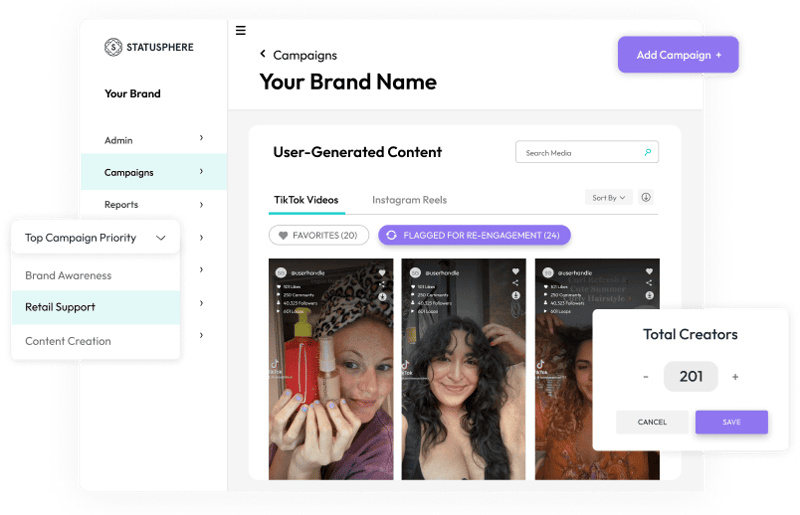Influencer Product Gifting: How to Run an Effective Gifting Campaign
Influencer gifting campaigns can build awareness and help brands get influencer content at scale. Here’s how to send products to influencers with a...
We dig into the most important details to include in an influencer agreement, plus our sample influencer contract template you can adapt for your brand!


“Do we really need an influencer agreement?
You’d rather focus on getting content over dealing with paperwork, right? We hear you!
However, contracts are a crucial piece of influencer campaign management.
And the more creators you work with, the more the fine print of those agreements matters.
With influencer contacts, you can confidently define the details of your working relationship with creators with less back-and-forth. All while avoiding huge headaches with legal compliance.
Below we break down what should go into your influencer agreements and contracts. We'll also share a simple influencer agreement template you can adapt yourself!
Skip to Section 👇What is an Influencer Agreement? Simple Influencer Agreement Template |
What is an Influencer Agreement?
An influencer agreement is a contract between brands and creators. These agreements outline expectations and requirements influencers must follow during campaigns. Influencer contracts also serve as a way for brands to cover their legal bases.
Influencer agreements and contracts are interchangeable. This might seem elementary but hey, you'd be surprised at how many brands work with creators without a contract!
If you've ever worked with contractors, most details of an influencer agreement will be familiar.
In short, an influencer contract covers details of your partnerships relationships including:
Scope of work and services
Deliverables and compensation
Content usage rights and exclusivity
Brand-specific guidelines
Terms of termination
Note that most but not all campaigns require an influencer agreement. For example, sending products to influencers via gifting campaigns is a contract-free process. That’s because you’re sending gifts with no strings attached. With that also comes the risk of getting ghosted.
|
👩🏫 Important: an influencer agreement is not the same as a creative brief! Contracts cover primarily business duties and legal responsibilities. Creative briefs convey the creative requirements of your creators' social posts. Working with influencers often involves one contract but multiple briefs. |
Here's a sample influencer agreement template that's simple but comprehensive.
This template provides an idea of what you need to talk over with both your marketing and legal teams before diving into a full-blown influencer campaign.
Using the agreement template above, here's a sample influencer contract with details filled in. A "real" influencer contract would be much longer, but this is mostly to illustrate clauses to consider for deliverables and outlining expectations.
This sample influencer contract highlights the attention to detail that brands should consider to cover their legal bases and promote positive influencer relations.
Creators shouldn’t be asked to sign contracts “just because.”
Let’s quickly look at why formal agreements are a win-win for brands and creators alike.
Whether full-time or as a side hustle, influencers are business owners.
And so brands should approach influencers like they would any other contractor.
Many influencers will expect a contract. They might bring their own terms to the table, too.
Food for thought: 79% of creators believe they're more valuable to brands by working with them long-term. Making your partnership “official” with a contract signals both sides’ commitment.
A formal influencer agreement means you're less likely to get ghosted by creators. On the flip side, handshake agreements offer no recourse for brands if a creator doesn’t post.
Note: this all illustrates the value of an influencer platform (like Statusphere) that guarantees content with rights management by default.
Communicating expectations is a big challenge among brands and creators.
Deadlines. Deliverables. The list goes on and on.
The clearer your expectations are from the word “go,” the better for both parties. Your influencer agreement serves as a document that states what’s expected of creators, simple as.
And if you want to demand more of your creators, your contract should reflect that.
Do you have a detailed content approval process? Want full content usage rights for ads? Do you expect influencers to report analytics to you?
Cool! Just make sure your agreement spells out all of the above.
Many companies run influencer marketing campaigns without ever running into legal compliance issues. It's always better to be safe than sorry, though.
Still, keep in mind what the FTC says about influencers and product endorsements:
“Your company is ultimately responsible for what others do on your behalf.”
For brands, a binding agreement offers peace of mind. Contracts can likewise deter potential influencer fraud and protect you in case something goes wrong.
“Okay, so I need to draft a contract. Now what?”
Onto the good stuff! Writing an influencer contract from scratch can feel like a balancing act. You want to cover all your bases but you don’t want to overwhelm creators with details.
But even if you’re using an influencer contract template like the one above, note that influencer promotions aren’t one-size-fits-all. This is especially true as platforms and industries evolve.
Below are key details to adapt to your contracts or any influencer agreement template you use.
Here you’ll summarize the big-picture details of your influencer partnership, including:
What is the nature of the relationship between you and the creator?
What deliverables are the creator responsible for (think: TikTok videos, Instagram Reels)?
What is the purpose of your influencer agreement? (one sentence summary)
Here you’ll delve into the specifics of the content and deliverables produced by the creator:
How many pieces of content is the creator responsible for?
Adherence to your brand guidelines, approval process and creative briefs
Exclusions (terms and/or competitors that should not be mentioned in posts)
Whether you (the brand) reserve the right to edit the creator’s content
Acknowledgment that all content created is original
Acknowledgment of FTC disclosures and best practices for influencers
Repurposing influencer and user-generated content is a smart move for brands. That said, you need to be clear about influencer usage rights if you plan to do so. This section of your influencer agreement should cover:
Who owns the rights to content produced by the creator?
Do the rights to your influencer content transfer back to the creator?
If so, when? (30 days, 60 days, 90 days, etc.)
Can content be repurposed by the brand (via influencer whitelisting or otherwise)?
The length of an influencer campaign can range anywhere from a few weeks to ongoing, always-on promotions. You may plan to work for influencers indefinitely which is totally fine. Just make sure your contact covers:
The effective date of your agreement
How long your agreement is valid for
Deadlines for submission, approval and revisions (if necessary)
How (and how much) to pay content creators is a hot topic. No matter how you go about it, your contact should be clear about:
The creator’s rate for their services (think: are they invoicing $[x] per post or hourly)
How the creator is being paid (think: direct deposit, PayPal)
Payment scheduling (think: upon receipt, invoicing, 14-day or 30-day payment terms)
The importance of influencer reporting can’t be overstated. That said, creators aren’t obligated to share numbers unless specified in their influencer marketing agreement. Consider:
Which engagement metrics they’re expected to track
How often they need to report their data (and over what period of time)
Tracking and formatting preferences (think: analytics screenshots versus reporting in a spreadsheet or email)
For your protection and freedom to cut ties with creators when things aren’t working out, termination clauses are critical. This includes:
An at-will termination clause
A breach of contract clause
A notice of termination clause
We get it: there’s a lot that goes into any given influencer agreement.
But covering all of these bases is crucial for both your protection and so that you and your creators are all on the same page.
And if you don’t want to deal with contracts or digital handshakes, we’ve got you covered.
Statusphere's scalable micro-influencer marketing platform eliminates the need to draft influencer contracts or worry about content rights management.
Our software only matches brands with influencers from our own vetted creator community using 300+ unique, first-party data points. Posts sourced from our influencers go directly into your brand portal with full content rights on your end.

Whether you want to run that content as ads, repost it or use it elsewhere it totally your call. We've already generated 100,000+ authentic pieces of UGC on behalf of 700+ brands.
Want to learn more about how our software works? Get in touch with one of our experts to see how we can get your brand more rights-ready creator content in a fraction of the time.
Disclaimer: We're influencer marketing specialists, not lawyers ourselves! This content is not legal advice and you should definitely consult a legal professional based on your needs and questions. We do not make any guarantees as to the accuracy or completeness of this information and take no liability or legal obligations for your use of this information.
This article was first published in November 2022. It was last updated February 12, 2025.
What is a social media influencer contract?
A social media influencer contract is an agreement between a content creator and a brand. The contract outlines the terms and conditions of an influencer collaboration, outlining expectations for both the brand and creators.
An influencer contract typically covers details such as the scope of work, compensation, deliverables and timeline. The contract also addresses issues such as content usage rights, ownership and compliance with FTC guidelines.
Contracts are recommended for influencer collaborations for the sake of covering legal bases, promoting commitment to the partnership and outlining appropriate expectations.
If nothing else, partnerships that include influencer contracts signal professionalism from both brands and creators.
However, there are certain types of influencer partnerships where contracts and formal agreements aren’t required or necessary. For example, brands that send products to influencers via gifting do not require contracts. This also means that the creator is under no obligation to post, though.
The way you create and manage influencer contracts will depend on your team's resources and capacity. You can discuss the specifics with your legal team and adapt it from your existing contractor agreements.
You can also hire a third-party legal service to help you draw up an influencer contract.
Alternatively, you can use a marketing platform like Statusphere which automates influencer contract management through pre-negotiated collaborations with vetted creators.

Influencer gifting campaigns can build awareness and help brands get influencer content at scale. Here’s how to send products to influencers with a...
Trying to figure out how to scale your influencer program? This post breaks down tell-tale signs you should scale your influencer marketing and ways...
Getting UGC at scale with influencer gifting doesn't happen by accident. Below we break down how to fine-tune your influencer gifting strategy to see...
Be the first to know about the latest tools, trends and strategies in influencer marketing for brands.